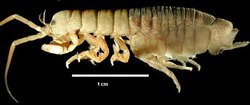Isopoda
|
|
| Isopods | ||||||||||
|---|---|---|---|---|---|---|---|---|---|---|
 Eophreatoicus (a freshwater isopod from Australia) | ||||||||||
| Scientific classification | ||||||||||
| ||||||||||
| Suborders | ||||||||||
|
Anthuridea |
Isopods are one of the most diverse orders of Crustaceans, with many species living in all environments, and are common in shallow marine waters. Unlike most crustaceans, isopods are successful on land (suborder Oniscidea, woodlice), although their greatest diversity remains in the deep sea (suborder Asellota). The isopods are an ancient group with fossils known from the Carboniferous (suborder Phreatoicidea, family Paleophreatoicidae) that only differ slightly from modern southern hemisphere freshwater phreatoicideans.
The Isopoda is a monophyletic order within the superorder Peracarida containing just over 10,100 named marine, freshwater and terrestrial species (M. Schotte, pers.comm.; see also Brusca & Brusca, 1990; Bruce, 2001; Dreyer & Wägele, 2002) of which over 1000 have been recorded from Australia (Poore, 2002c). Synapomorphies which define this order include: (1) sessile eyes (when present); (2) the carapace reduced to a cephalic shield; (3) all pereiopods lacking exopods; (4) pleonite 6 fused to the telson forming a pleotelson; (5) biphasic moulting; (6) a thoraco-abdominal heart; (7) abdominal branchial structures; (8) an ectodermally-derived gut without a true midgut region; (9) the presence of striated muscles with a unique myofibril ultrastructure; and (10) uropodal rami which are always uniarticulate (Brusca & Wilson, 1991). Synapomorphies (1), (2) and (3) may be convergent with the condition found in the peracaridan order Amphipoda, and synapomorphy (4) with the condition occurring in the order Tanaidacea but confirmation of this requires further analysis of the entire Peracarida (Brusca & Wilson, 1991). Other features which characterise some peracaridan orders and which are also found in the Isopoda include: the first thoracomere fused to the head; one pair of maxillipeds; the pereopodal coxae expanded to form coxal plates; the presence of oostegites in females; a manca stage in the life cycle; and well developed, biramous pleopods which are used for gas exchange and swimming (Brusca & Brusca, 1990). Several phylogenetic studies have emphasised problems with the subordinal classification of the Isopoda (Wägele, 1989; Brusca & Wilson, 1991; Tabacaru & Danielopol, 1999). Many of these problems are summarised by Martin & Davis (2001) and further examined by Dreyer & Wägele (2002) and Poore (2002c). These latter two studies present alternative classifications which are yet to be broadly adopted. Aspects of isopod anatomy, systematics and biology have recently been reviewed by Roman & Dalens (1999) and Trilles (1999). The Australian fauna is documented in Poore (2002c) which also includes a historical overview of systematic study of the group in this region and provides diagnoses of the higher taxa.
Note: this paragraph is modified from Keable et al., 2002 (http://www.crustacea.net/crustace/isopoda/index.htm).
External links
- Smithsonian Institution World List of Marine, Freshwater and Terrestrial Isopod Crustaceans (http://www.nmnh.si.edu/iz/isopod/about.html)
- Buz Wilson's Isopod Sites Page (http://www-personal.usyd.edu.au/~buz/isosites.html)
- suborder Phreatoicidea (http://www-personal.usyd.edu.au/~buz/phreamenu.html)
- suborder Asellota (http://www-personal.usyd.edu.au/~buz/asellota.html)
- suborder Oniscidea (http://asso.univ-poitiers.fr/t%2Disopods/)
- Prof. Chuck Holliday's Research Page (http://ww2.lafayette.edu/~hollidac/research.html), Prof. Chuck Holliday, Dept. of Biology, Lafayette College. Contains links to articles on osmoregulation in isopods and other crustaceans.
References
Isopoda references (http://www.crustacea.net/crustace/isopoda/refs.htm) fr:Isopoda
